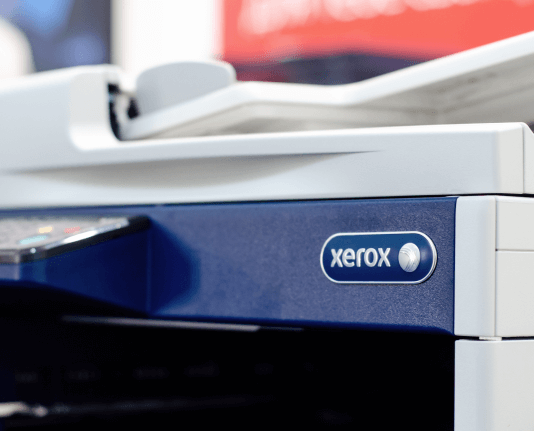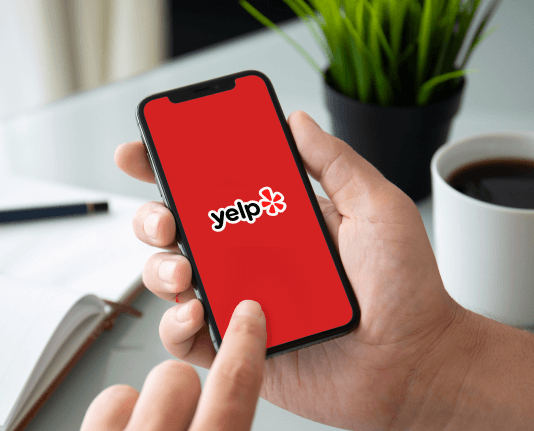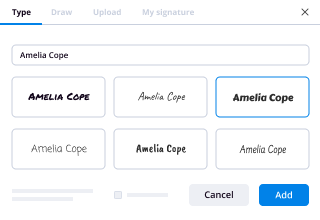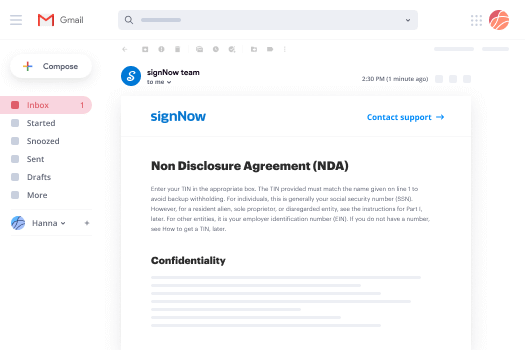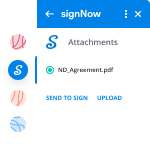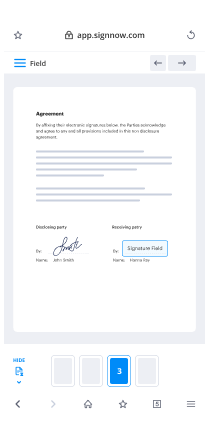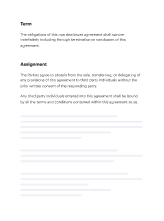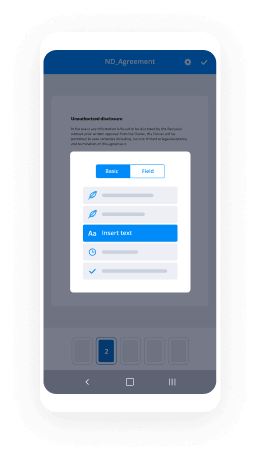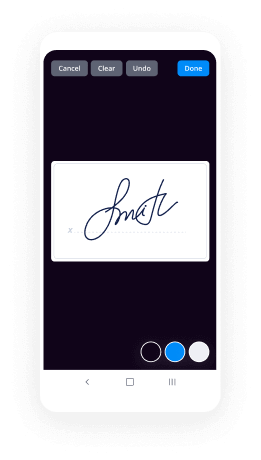How Do I Implement Sign in Google Drive
Contact Sales
Make the most out of your eSignature workflows with airSlate SignNow
Extensive suite of eSignature tools
Robust integration and API capabilities
Advanced security and compliance
Various collaboration tools
Enjoyable and stress-free signing experience
Extensive support
Keep your eSignature workflows on track
Our user reviews speak for themselves






How to enhance Google with airSlate SignNow advantages
If you're aiming to boost Google search efficacy for your enterprise, utilizing tools such as airSlate SignNow can signNowly improve your document management process. This platform presents an array of advantages that simplify the signing procedure, facilitating businesses in managing contracts and agreements proficiently.
Procedure to enhance Google utilizing airSlate SignNow
- Visit the airSlate SignNow website in your chosen browser.
- Sign up for a free trial account or log into your current account.
- Choose the document you want to upload for signature or sharing.
- If you intend to reuse this document, save it as a template for future reference.
- Retrieving the uploaded file, personalize it by inserting fields for signatures or required information.
- Add signature fields for your signers and sign your own document as necessary.
- Click on 'Continue' to set up and send the eSignature invitation.
Utilizing airSlate SignNow empowers businesses to efficiently oversee their document signing operations, yielding an outstanding return on investment through its all-encompassing features. The platform is user-friendly and adapts well, making it an excellent option for small to medium-sized enterprises.
Prepared to improve your document workflow? Begin your journey with airSlate SignNow today and discover the advantages of exceptional support and clear pricing for your business requirements!
How it works
Rate your experience
-
Best ROI. Our customers achieve an average 7x ROI within the first six months.
-
Scales with your use cases. From SMBs to mid-market, airSlate SignNow delivers results for businesses of all sizes.
-
Intuitive UI and API. Sign and send documents from your apps in minutes.
A smarter way to work: —how to industry sign banking integrate
FAQs
-
What features does airSlate SignNow offer for users who utilize drive Google?
airSlate SignNow provides seamless integration with drive Google, allowing users to easily upload, send, and eSign documents stored in their Google Drive. With features like template creation, bulk sending, and real-time status tracking, managing documents becomes effortless. This integration ensures that your workflow remains efficient and organized by keeping all your files in one accessible location.
-
How can I integrate airSlate SignNow with drive Google?
Integrating airSlate SignNow with drive Google is straightforward. Simply connect your Google account to airSlate SignNow through the settings menu, and you'll have direct access to your Google Drive files. This integration allows you to send documents for eSignature without leaving the drive Google interface.
-
Is there a free trial for airSlate SignNow that works with drive Google?
Yes, airSlate SignNow offers a free trial that allows you to explore its features, including the integration with drive Google. During the trial period, you can test sending and signing documents directly from your Google Drive. This is a great way to evaluate how airSlate SignNow can enhance your document management processes.
-
What is the pricing structure for airSlate SignNow when using drive Google?
airSlate SignNow offers several pricing plans that cater to different business needs, all of which support integration with drive Google. The plans are designed to be cost-effective, giving you access to essential features for document management and eSignatures. You can choose a plan that suits your volume of usage and the features you require.
-
What are the benefits of using airSlate SignNow with drive Google?
Using airSlate SignNow with drive Google streamlines your document handling process by combining eSignature capabilities with cloud storage. This integration enhances collaboration, allowing multiple users to access and sign documents from anywhere. Additionally, it keeps your documents organized within Google Drive, improving overall productivity.
-
Can I use airSlate SignNow on mobile devices while accessing drive Google?
Absolutely! airSlate SignNow is mobile-friendly, allowing you to manage your documents and eSign directly from your smartphone or tablet. When connected to drive Google, you can access your files and complete signing workflows on the go, ensuring you never miss an opportunity to finalize important documents.
-
Does airSlate SignNow provide security for documents stored in drive Google?
Yes, airSlate SignNow prioritizes the security of your documents, including those stored in drive Google. The platform employs advanced encryption protocols to protect your data during transmission and storage. Additionally, you can manage permissions and access levels, ensuring that only authorized users can view or sign your documents.
-
What are the most effective ways to promote blogs?
My blog is relatively young(ish). It was very frustrating at first, as I thought getting people to read it would be fairly easy - boy, was I wrong! So, I read and I read countless articles on how to drive traffic to my blog, and, honestly, I very rarely stumbled upon something actually helpful. Most of them just repeated each other, or only gave some very unadequate advice - nothing that can help you when you are just getting up to 10–20 pageviews a day. So, here I am still experimenting and finding my way. I am having some peaks here and there, with some days up to 2000 pageviews. Once I even had 10k for a day! But usually I range between 300 and 400/day. It’s probably minor for a lot of blogers out there, but for me so far it is progress.So what works the best for me so far?No doubt - Pinterest! Here’s what I learned so far:You need to be crazy patient with Pinterest - building a following there is an incredibly slow process - no matter how often you pin. But that’s fine. You don’t need a ton of folloers to create a viral pin or to have an extensive signNow. When I had about 250–60 followers, my signNow was over 1.6million - much bigger than what other people with thousands of followers have.Switch to a business account (it’s really easy) and activate rich pins for your website (there are tons of explanation out there how to do it).Create a bunch of boards with SEO-optimized titles (think: terms that people search for). Over time, keep creating more boards. Add description for each one of them. Most importantly - create a board with the name of your blog.Every time you create a pin for your new blog post - pin it on your blog board first. From there - pin on every other board that you find relevant.Join group boards. Usually, you can find directions how to join the board in its description. It’s not gonna work every time though, but don’t sweat it. Also, not all group boards are worth joining, even if they have thousands of followers, they could still have a very low repin rate.Pinterest is all about the visual appeal. You have to create very clean, beautiful, and capturing pins in order to get repined. Use only vertical pins. I use PicMonkey (paid version) and Canva (free) to create my pins and they work great. Always put the name of your website on your pins (like with small letters on the bottom of the pin for example).Pin like a madman/madwoman. Not just your stuff, but find popular, credible, and nicely looking pins that are relevant to your boards and pin them. They say that Pinterest likes team players - I guess there’s truth it that. But at the same rate - repin your own content. See what are your most visited hours and repin around those times. Repin on your own content on your own board. A.lot.There’s a lot more little details about Pinterest that you get to notice the more you use it. To be honest, I really only use it, because it’s such a great traffic provider. I actually don’t get the appeal of it at all and don’t understand why someone would waste their time on there…but hey, whatever brings me traffic..Of course, I also optimize my blog post for search engines. Thanks to that, I know get more and more visits coming from Google or other SEs.I believe that Instagram could be a big traffic booster as well but there’s a whole new algorithm to figure out and fight through and I am still not that far yet.So, in short, that’s my two ways of driving traffic to my baby blog - Pinterest and SEO.Hope that that helps someone.
-
How do I learn machine learning?
Machine Learning today is one of the most sought-after skills in the market. A lot of Software Engineers are picking up ML, simply because it is a highly paid skill. So, how do you learn Machine Learning? * First things first - the prerequisites: * * Basic calculus. In Machine Learning, you’d be working on a lot of optimizations that require knowledge of Calculus. It would be highly recommended that you are aware of functions, limits, differentiation, maxima, minima, etc. * Linear Algebra. When you talk about ML, you will be dealing with matrices and vectors every day. So, knowledge of Linear Algebra is a must. However, you’d also be required to know about other important topics like Eigenvalues and Eigenvectors. * Probability. Most ML algorithms try to “model” the underlying phenomena that generated the observed data. All of this modelling is probabilistic. It is therefore highly recommended that you are comfortable with the theory of Probability. * Getting into actual ML: * * Take a great online course on ML. The most well-known course is the one offered by Andrew Ng (Coursera) [ https://goo.gl/yH1fqV ]. It is a great course and it teaches you the basics of Machine Learning - Regression, classification, various ML algorithms, etc. The course also requires you to build a digit recognition system. * Once you have the basics in place, it would be a great idea to practice some problems on Kaggle [ https://www.kaggle.com/ ]. Kaggle is a well-known Machine Learning contest platform where you can compete with others in training ML models on various datasets. * Take up ML projects. This is the most important point. Ideally, you’d want to have not only ML experience but also some great projects on your resume that you can showcase. These projects will help you distinguish yourself from other candidates. After searching a lot for courses that teach ML through projects, I found the one by Eduonix [ https://goo.gl/fzLQ4D ] quite relevant. The best way to learn Machine Learning is to actually apply it to real datasets and solve real problems. Machine Learning is as much of an art as it is a science. You will learn it from experience. Your focus should be on attempting multiple ML projects so as to gain experience and build a strong profile. You may also want to read these answers: * Aman Goel's answer to Which are the best online courses for machine learning? [ https://www.quora.com/Which-are-the-best-online-courses-for-machine-learning/answer/Aman-Goel-9 ] * (ignore the title of the question. Focus on the answer) - Aman Goel's answer to How do I compete with the students studying in IITs while studying in a mediocre college? [ https://www.quora.com/How-do-I-compete-with-the-students-studying-in-IITs-while-studying-in-a-mediocre-college/answer/Aman-Goel-9 ]
-
What are the best ways to think of ideas for a startup?
When people share startup ideas, your job is not to poke holes into the idea, it’s to figure out how it can win. How could they become a billion-dollar company?I graduated from Y-Combinator which is arguably the world's best startup program, and they have a great model for thinking of and evaluating startup ideas.Startups are businesses that aim for rapid growth, and startup ideas are a hypothesis of why they can grow quickly. When considering whether or not to pursue a startup idea, It’s a good practice to break it down into three parts: problem, solution, and insights.THE PROBLEMPeople should always try to start by thinking about problems. In this way, your aim is to uncover the setting which allows your startup idea to grow fast. It also focuses your mind on creating the most value for people.Startup investors look for problems that meet some or all of these criteria:Popular - Everyone or a lot of people have your problem.Growing - The market (demand) is growing so fast that more and more people are having the problem.Urgent - The problem needs to be solved quickly.Expensive - The problem is expensive to solve, meaning that at a bare minimum it’s a multi-million dollar industry.Mandatory - People who have this problem NEED to solve it.Frequency - People encounter your problem over and over again in frequent time intervals. This one is super important as it gives people a lot of opportunities to turn into customers.The ideal startup for investors: has the potential of over 1 million users, has 20% market growth year over year, and the problem needs to be solved right now. Needly to say, It also has the potential to make billions of dollars.Some of the best ideas tackle problems that happen hourly or daily, so ask yourself “does the problem need to be solved today?”Bonus: Many great startup ideas were inspired by law changes!THE SOLUTIONThe greatest advice Y-Combinator give founders is to not start here when you’re brainstorming startup ideas. Focus on the problem. Do whatever it takes to solve people's problems/issues.Since we are starting out with a startup idea which is a hypothesis, we first need to think of the problem. Afterward, we go out and test our hypothesis by talking and testing with potential customers. Only after experimenting and talking to customers do brilliant solutions appear.(Elon Musk started by asking himself what were the most important problems he could solve? Many great founder and CEO’s started the same.)INSIGHTS / UNFAIR ADVANTAGESUnfair advantages relate to growth, and to be an extremely successful startup, you need one. You don’t need all of them but most billion-dollar startups have more than one unfair advantage.Unfair advantages:Founders - You’re 1 out of 100. Are you a super expert in your industry? Are you a Ph.D. student in a very small field? Are you an exceptional salesman? Being just above average doesn’t cut it.Market - Does the market have 20% growth rates or higher? Note that this is the weakest advantage you could have.Product - Your product is 10x better. it’s not enough for it to be 2x or 3x better. What makes it an advantage is that it’s hard for others to replicate.Aquisition - It costs $0 to get customers. Can it spread by word of mouth or do you have a free advantage? This usually means having a big social media following or audience from a previous business.Monopoly. As the company grows is it harder for competitors to win?One last thing to consider when evaluating ideas is your beliefs.What’s your threshold and can you create miracles?Ask yourself: can I even build my startup idea? How well can I do sells, tell a story, and convince customers? (critical for making money and keeping your business alive) Can I work through the sales process? Can I withstand hard times?—Here’s a free google spreadsheet to EVALUATE YOUR STARTUP IDEASI plan on writing every day about startups and business so feel free to follow me for more ideas, advice, and templates. Cheers and thanks for reading!
-
How can I stop being so addicted to my phone?
An addiction is when the thing you are addicted to begins to control your life and interferes with your daily activities, work, and relationships. The classical definition of an alcoholic is someone who wakes up to a glass of vodka instead of a cup of coffee. But with the boom of technology, the signs of addiction can also be found in other places besides the bottom of a glass, it can also be found in the form of cell phones. If you find yourself checking your phone first thing in the morning—before even getting out of bed, you may be addicted. If you find you’re text-messaging while driving, checking your phone instead of working on an important assignment, or checking Facebook during a romantic dinner—your phone is interfering with your life and you are addicted. Are missing out on living a fulfilled and rich life because you’re constantly staring at your cell phone? Here are five tips to manage your phone addiction. 1. The first 30 minutes of your day If you find yourself waking up in the morning signNowing to check in with your phone before you even got out of bed, this is a serious problem. The first 30 minutes upon awakening should be dedicated to creating a good start to your day. This means getting out of bed, freshening up, taking 5 minutes to meditate and stretch and preparing a healthy breakfast. Start your day doing healthy, positive things to build your inner fortitude to take on the day ahead. 2. Create No-Phone Time Zones The truth of the matter is having a cell phone close by at work is common, and sometimes even required. Whether the ding of your phone is work-related or not—that specific phone alert is rarely related to the current work at hand. If you are constantly getting distracted by your phone going off—you won’t remain focused on the work in front of you, decreasing productivity. Therefore, I advocate for creating a no-phone time-zone. This means that for at least 2 hours of your day(when you’re most productive work happens) you close off your phone and stay completely dedicated to the work in front of you. 3. Turn your Phone Off When You Get Into The Car This should be a law. I’m waiting for the day that it is. Just as in an aircraft you are asked to power off your electronic devices and cell phones, this should be the law of the road. It is impossible for your mind to be at two places at once. It is a law of physics: no one thing can occupy the same space at the same time, and if your mind and eyes are on your phone, they are not on the road. Driving is one of those places where you do not want to mess around. Sometimes I hear the excuse “Well, I need my phone for directions, my GPS is on it.” To that I say: what did people do five years ago? You would carefully map out your route before you left the house, or you would pull off to the side of the road as you looked at a map. The same rule should apply today. When driving—close off your phone so that you are not even tempted to look at it. Your life and other people’s lives are at stake. 4. Get Real When you are with a real life person sharing a conversation, a meal, or a cup of coffee, they are a real life form. A real person right there in front of you to engage with. Are you telling me that your virtual friends and virtual text conversations are more important than the real life person in front of you? Not only is this THE rudest thing on the planet, but it breaks down friendships and can ruin relationships. Even if you say to a friend “Oh I just need to check that,” They may respond “Oh, that’s OK.” But the truth is it’s not OK. What you are saying is that the virtual message is more important than them. They have taken time out of their busy life to meet with you, and share real life time with you. By turning your attention away from them you are inevitably saying “You are not as important.” It’s really a sickness that we are so addicted to our phones that we ignore the people we are with to hang out with virtual people over Facebook, Twitter, and text messages. Come on people—it’s time to get real. 5. Don’t Lose Sleep Over It If you find yourself up late at night playing on your phone, whether it is video games, Facebook, or text messaging, you are losing precious sleep over your addiction. The moment you stop putting energy into caring for your basic needs and pour your time and energy into your phone, you are allowing the phone to dictate your health and well-being. If you catch yourself in this scenario, my advice is to power off your phone an hour before bed time to ensure that your last hour is spent in a meaningful way, and that you get to bed on time to start the next day afresh. Your phone is just not worth losing sleep over. Now it’s your turn. Do you find yourself in one of these scenarios? What’s your plan of action to ensure that your phone isn’t dictating your life? Please share in the comments below, and let’s inspire each other to live healthier, happier, more meaningful lives by not caving into a phone addiction.
-
How can I increase the traffic on my website?
I would say VIDEO MARKETING is your answer. Why? Because everyone will be looking for videos in 2018. The Six Point Checklist for Video Marketing Domination [ https://medium.com/@flaviu_91616/the-six-point-checklist-for-video-marketing-domination-8078ca148447 ] Why becoming your OWN Media Company will keep your business alive in 2018 [ https://medium.com/@flaviu_91616/why-becoming-your-own-media-company-will-keep-your-business-alive-in-2018-560f06c40afa ] Video is all about communicating an idea to the crowds. Crowds of people looking for something special, something that makes the click in a special way. Video content [ https://www.patonmarketing.com/ ] is fast, it provides an instant reaction from your audience, it communicates on multiple levels. The massive growth of video marketing during the past 10 years is truly incredible — let’s see some statistics [ https://www.patonmarketing.com/audit-your-site/ ] that will blow your mind! * YouTube has 1 billion registered users — that’s more than a third of the total internet users worldwide (1) [ https://www.youtube.com/yt/about/press/ ] * more than 72 hours of video content is uploaded on YouTube every 60 seconds (1) [ https://www.youtube.com/yt/about/press/ ] * 85 percent of Americans watch video online (2) [ http://www.comscore.com/Insights/Press-Releases/2012/1/comScore-Releases-December-2011-US-Online-Video-Rankings?cs_edgescape_cc=US ] * 82 percent of Twitter users watch video on the platform (3) [ https://blog.hootsuite.com/twitter-statistics/ ] * 87 percent of digital marketers use video content (4) [ http://www.outbrain.com/blog/state-of-content-marketing-2012 ] * 90 percent of video traffic on Twitter comes from mobile devices (3) [ https://blog.hootsuite.com/twitter-statistics/ ] * 92 percent of video users share their videos with others (5) [ https://www.virtuets.com/45-video-marketing-statistics/ ] * more than 350,000 hours of broadcasts are streamed daily on Periscope (6) [ https://www.omnicoreagency.com/periscope-statistics/ ] * Snapchat users watch 10 billion videos every day (7) [ http://mashable.com/2016/04/28/snapchat-video-views-billion/#QKsc_s0Oruqu ] * 50 percent of potential customers look for a video related to a product before making a purchase (14) [ https://www.thinkwithgoogle.com/marketing-resources/micro-moments/purchase-decision-mobile-growth/ ] * shoppers who view video demos or reviews are 1.81x more likely to make a purchase (15) [ https://blogs.signNow.com/digitalmarketing/search-marketing/seo-for-success-in-video-marketing/ ] * 4 times as many customers would rather watch a video on a product than read about it (16) [ https://animoto.com/blog/business/video-marketing-cheat-sheet-infographic/ ]
-
As a software developer, how often do you leave a backdoor in your code?
Not quite an answer to the question, just a different take on “backdoor”.In the 70’s, I worked at a University in the computer department. Part of my tasks was to assist State employees and contractors with computer problems, or to discover why a particular task was consuming too much time.One State contractor was tasked with accessing data from our mainframe using APL. But the code they wrote was horrendous, and caused frequent stops due to consuming too much computer without a human interaction.The biggest problem they had was in file accesses. They would open a file, read a record (random), then close the file, then repeat the process.My task was to (1) find why they were using so much time and (2) fix it. While I was not prepared to re-write all their APL (very high level statistics), it was clear to me that they lacked the knowledge of the file system. So over the course of a few days, I wrote a set of access routines that would simplify their file access and speed their processes. I calculated that is sped up their file access by a factor of 100.But this State contractor had a habit of not understanding computers and having people re-write (or originally write) large sections of their code, then claim it as their own.So, I “locked” it. Basically, this provided a means whereby the user can access the code, but has no ability to open the source. A lot like a DLL today, except that a DLL can be hacked down to assembly language. Locking an APL function gave NO ability at all to see any internals. In fact, once you locked it, not you, not even the system admin, could open it up. The ultimate in code security.I provided him a folder with which to grab the code and told him to let me know if they had any problems, and, if it was all working, to let me know by April 15 (4 weeks hence).About 2 days later, he calls to say that the code is not viewable. I told him that he didn’t need to know the internals of how the code was structured. If it did not function according to the documentation, I would fix it for him; that’s my job! He was not happy.Even more unhappy on April 16, because the code would no longer run. Not only had I locked the functions, I had also place a timebomb in the code that expired at midnight on April 16. He called in a panic. I calmly reminded him that I had asked him to let me how the code was working for him before that date. He stated that it was working just fine, many thanks, great job, …. It all sounded like BS, actually.So, I made the neutered code available to him (still locked of course),he downloaded it, and left “happy”.I got two things out of this.I was acknowledged for my work, and my work was not claimed by someone else.He never asked us to write any code for him again.Win, Win.
-
Is working at Google as difficult as its interview process?
Working there is a lot easier, as far as the amount of thinking, creativity, intelligence, etc required.Once at Google, you’ll likely find yourself slowly going nowhere on nothing in particular, while working long hours. That is, the work is usually pointless, meaningless, and irrelevant.On the flip side, once you’re hired, you can essentially coast for many years, while doing almost nothing. Also, the less drive/ambition you have, the less you’ll be affected by political games, an absence of promotions, being put on a crappy part of a legacy product, etc (ie, you won’t really care when they try to waste your abilities, drown you in endless BS work, or try to have everything lead to a dead end).You’d think at this point you’d be looked at unfavorably, but I kept noticing it was those who politicked or tried to coast that would receive promotions and large bonuses. That is, if you’re just about rising and making money, then if you find yourself doing actual work, you know you’re going to lose.Google doesn’t really get rid of low performers, so if coasting results in little to nothing being done, you’ll probably have nothing to worry about. That is, accusations of low performance are usually only made when management is trying to push someone out for other reasons (see them as a threat, don’t want to pay, want credit for something they did, etc).Eventually, after having done nothing for many years, you’ll likely have difficulties finding another job, as your skills will be out of date; however, those that want to coast usually have no plan on quitting— ever.
-
How do I implement a single sign on like Google?
Start Integrating Google Sign-In into Your Android App | Google Sign-In for Android | Google DevelopersGoogle Login Android Tutorial - Integrate GPlus LoginCheck these outGood Luck
-
How do I implement Google sign in in a Java app?
It is imperative that you understand what OAuth is, and what “flows” or “workflows” or “grants” in OAuth are.Then, you’ll know that you need to program the “Authorization Code Flow” of OAuth 2.0 to have your server-side Java code to become an OAuth client.This is a YouTube playlist I created that explains what OAuth is, what the flows are, how the Authorization Code Flow works and also has a demo in C#, which should be very easy to port to Java.OAuth 2.0 - YouTubeAll the best.In particular, an overview of what OAuth is, the explanation for the code and the code itself are in the two videos given below.What is OAuth?OAuth 2.0 Authorization Code FlowDemo - OAuth 2.0 Authorization Code Flow
Trusted esignature solution— what our customers are saying
Get legally-binding signatures now!
Related searches to How Do I Implement Sign in Google Drive
Frequently asked questions
How do i add an electronic signature to a word document?
How do you know an electronic signature is real?
How to eSign a pdf in instanet?
Get more for How Do I Implement Sign in Google Drive
Find out other How Do I Implement Sign in Google Drive
- 2015 form 940 schedule a
- C ez 2015 form
- 2011 irs form 990 ez
- 2012 8938 form
- 2011 form 1120 f
- Form 1099a 2011
- Govform1099oid
- 2011 social security worksheet form
- 2015 1040ez form
- 2012 form 8854
- 2006 form 3
- 2013 8815 form
- 2009 form 8917
- 2013 4136 form
- 2012 schedule b form
- Form 8829 2015
- 2010 8379 form
- 1099 c 2014 form
- 2013 irs schedule d form
- 2014 irs address form

